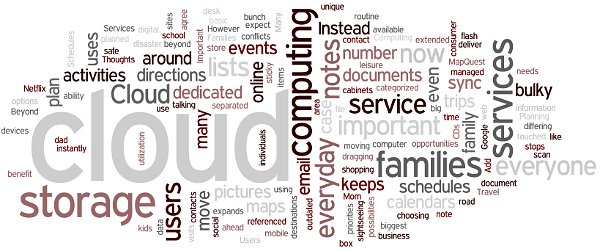Cloud computing utilization is often referenced when talking about managed business data, IT jargon and big consumer services such as Netflix. However, “the cloud” is for everyone and there are a number of ways cloud computing can benefit families and individuals.
Most don’t realize that they’re already using some form of cloud computing everyday. Services such as email, online banking and social websites can all be categorized as cloud computing, but beyond those everyday uses are a number of other more dedicated uses.

Saving Important Documents
The rise of cloud storage has meant the ability to do away with those bulky file cabinets, piles of loose documents and drawers full of label-less flash drives and CDs. Anyone with important documents can now scan them into a computer and instantly sync them with a cloud storage service of their choosing. Many online services now deliver important information through email or dedicated document area on the web where users can move files from service to storage with ease.
Instead of cluttering a desk with sticky notes and note paper, users can store their contacts, shopping lists and other notes in the cloud. The biggest use case for cloud storage is that of pictures. Arguably the most important of all digital items is that of pictures. Cloud storage keeps them safe and copied in case of disaster.
Managing Schedules
As a family there are various priorities from each individual. Mom and dad have differing work schedules and the kids have after school activities. Add to that parties, leisure activities and visits from extended family and what you’ve got is a bunch of scheduling conflicts.
In order to keep everyone up to date on changes and routine schedules, families can sync calendars in the cloud. In addition to sharing calendars and events, families can share to do lists, notes and even contact lists. The cloud keeps everyone connected even though they may be separated due to their own unique interests and events.
Travel Planning
Most would agree that services like MapQuest and Google Maps have made moving around much easier. Instead of dragging around outdated maps in the glove box or bulky atlases in the trunk, users can plan trips ahead of time for printing or access the directions on mobile devices.
Beyond basic directions, maps are being incorporated into cloud travel sites and services. Users can now plan road trips with planned stops and sightseeing destinations.
Final Thoughts
There are so many cloud options available that families can find almost any service to fit their needs. We’ve only touched on a few of the many possibilities and as the cloud expands at an exponential rate, expect more and more opportunities to move everyday tasks to the cloud.
Looking for more cloud opportunities? Ask us!
If you enjoyed or found this article useful, please show us some support by liking us on Facebook or by sharing us on your favorite social website. Thanks!

